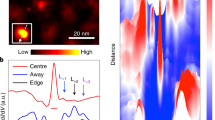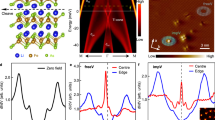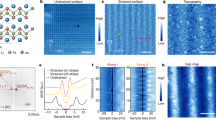Abstract
Majorana quasiparticles in condensed matter are important for topological quantum computing1,2,3, but remain elusive. Vortex cores of topological superconductors may accommodate Majorana quasiparticles that appear as the Majorana bound state (MBS) at zero energy4,5. The iron-based superconductor Fe(Se,Te) possesses a superconducting topological surface state6,7,8,9 that was investigated by scanning tunnelling microscopy (STM) studies, which suggest such a zero-energy vortex bound state (ZVBS)10,11. Here we present ultrahigh energy-resolution spectroscopic imaging (SI)–STM to clarify the nature of the vortex bound states in Fe(Se,Te). We found the ZVBS at 0 ± 20 μeV, which constrained its MBS origin, and showed that some vortices host the ZVBS but others do not. We show that the fraction of vortices hosting the ZVBS decreases with increasing magnetic field and that local quenched disorders are not related to the ZVBS. Our observations elucidate the necessary conditions to realize the ZVBS, which paves the way towards controllable Majorana quasiparticles.
This is a preview of subscription content, access via your institution
Access options
Access Nature and 54 other Nature Portfolio journals
Get Nature+, our best-value online-access subscription
$29.99 / 30 days
cancel any time
Subscribe to this journal
Receive 12 print issues and online access
$259.00 per year
only $21.58 per issue
Buy this article
- Purchase on Springer Link
- Instant access to full article PDF
Prices may be subject to local taxes which are calculated during checkout




Similar content being viewed by others
Data availability
The data that support the findings of this study are available from the corresponding author upon reasonable request.
References
Nayak, C., Simon, S. H., Stern, A., Freedman, M. & Das Sarma, S. Non-Abelian anyons and topological quantum computation. Rev. Mod. Phys. 80, 1083–1159 (2008).
Alicea, J. New directions in the pursuit of Majorana fermions in solid state systems. Rep. Prog. Phys. 75, 076501 (2012).
Sato, M. & Ando, Y. Topological superconductors: a review. Rep. Prog. Phys. 80, 076501 (2017).
Ivanov, D. A. Non-Abelian statistics of half-quantum vortices in p-wave superconductors. Phys. Rev. Lett. 86, 268–271 (2001).
Fu, L. & Kane, C. L. Superconducting proximity effect and Majorana fermions at the surface of a topological insulator. Phys. Rev. Lett. 100, 096407 (2008).
Wang, Z. et al. Topological nature of the FeSe0.5Te0.5 superconductor. Phys. Rev. B 92, 115119 (2015).
Wu, X. et al. Topological characters in Fe(Te1−xSex) thin films. Phys. Rev. B 93, 115129 (2016).
Xu, G. et al. Topological superconductivity on the surface of Fe-based superconductors. Phys. Rev. Lett. 117, 047001 (2016).
Zhang, P. et al. Observation of topological superconductivity on the surface of an iron-based superconductor. Science 360, 182–186 (2018).
Wang, D. et al. Evidence for Majorana bound states in an iron-based superconductor. Science 362, 333–335 (2018).
Chen, M. et al. Discrete energy levels of Caroli–de Gennes–Matricon states in quantum limit in FeTe0.55Se0.45. Nat. Commun. 9, 970 (2018).
Mourik, V. et al. Signatures of Majorana fermions in hybrid superconductor–semiconductor nanowire devices. Science 336, 1003–1007 (2012).
Nadj-Perge, S. et al. Observation of Majorana fermions in ferromagnetic atomic chains on a superconductor. Science 346, 602–607 (2014).
Kim, H. et al. Toward tailoring Majorana bound states in artificially constructed magnetic atom chains on elemental superconductors. Sci. Adv. 4, eaar5251 (2018).
Hosur, P., Ghaemi, P., Mong, R. S. K. & Vishwanath, A. Majorana modes at the ends of superconductor vortices in doped topological insulators. Phys. Rev. Lett. 107, 097001 (2011).
Guan, S.-Y. et al. Superconducting topological surface states in the noncentrosymmetric bulk superconductor PbTaSe2. Sci. Adv. 2, e1600894 (2016).
Iwaya, K. et al. Full-gap superconductivity in spin-polarised surface states of topological semimetal β-PdBi2. Nat. Commun. 8, 976 (2017).
Hanaguri, T., Niitaka, S., Kuroki, K. & Takagi, H. Unconventional s-wave superconductivity in Fe(Se,Te). Science 328, 474–476 (2010).
Rinott, S. et al. Tuning across the BCS–BEC crossover in the multiband superconductor Fe1+ySexTe1−x: an angle-resolved photoemission study. Sci. Adv. 3, e1602372 (2017).
Caroli, C., de Gennes, P. G. & Matricon, J. Bound fermion states on a vortex line in a type II superconductor. Phys. Lett. 9, 307–309 (1964).
Xu, J.-P. et al. Experimental detection of a Majorana mode in the core of a magnetic vortex inside a topological insulator-superconductor Bi2Te3/NbSe2 heterostructure. Phys. Rev. Lett. 114, 017001 (2015).
Sun, H.-H. et al. Majorana zero mode detected with spin selective Andreev reflection in the vortex of a topological superconductor. Phys. Rev. Lett. 116, 257003 (2016).
Machida, T., Kohsaka, Y. & Hanaguri, T. A scanning tunneling microscope for spectroscopic imaging below 90 mK in magnetic fields up to 17.5 T. Rev. Sci. Instrum. 89, 093707 (2018).
Yin, J.-X. et al. Observation of a robust zero-energy bound state in iron-based superconductor Fe(Te,Se). Nat. Phys. 11, 543–546 (2015).
Massee, F. et al. Imaging atomic-scale effects of high-energy ion irradiation on superconductivity and vortex pinning in Fe(Se,Te). Sci. Adv. 1, e1500033 (2015).
Liu, Q. et al. Robust and clean Majorana zero mode in the vortex core of high-temperature superconductor (Li0.84Fe0.16)OHFeSe. Phys. Rev. X 8, 041056 (2018).
Hayashi, N., Isoshima, T., Ichioka, M. & Machida, K. Low-lying quasiparticle excitations around a vortex core in quantum limit. Phys. Rev. Lett. 80, 2921–2924 (1998).
Biswas, R. R. Majorana fermions in vortex lattices. Phys. Rev. Lett. 111, 136401 (2013).
Chiu, C.-K., Machida T., Huang Y., Hanaguri T. & Zhang F.-C. Scalable Majorana vortex modes in iron-based superconductors. Preprint at https://arxiv.org/abs/1904.13374 (2019).
Liu, T. & Franz, M. Electronic structure of topological superconductors in the presence of a vortex lattice. Phys. Rev. B 92, 134519 (2015).
Sun, Y. et al. Effects of annealing, acid and alcoholic beverages on Fe1+yTe0.6Se0.4. Supercond. Sci. Technol. 26, 015015 (2013).
Sun, Y. et al. Dynamics and mechanism of oxygen annealing in Fe1+yTe0.6Se0.4 single crystal. Sci. Rep. 4, 4585 (2014).
Acknowledgements
The authors thank C.-K. Chiu, A. Furusaki, P. A. Lee, D.-H. Lee, Y. Nagai and T. T. Ong for valuable comments and C. J. Butler for a critical reading. This work was partly supported by CREST project JPMJCR16F2 from the Japan Science and Technology Agency, Grants-in-Aid for Scientific Research (KAKENHI) (numbers 17H01141, 16H04024, 19H01843), a Grant-in-Aid for Young Scientists (KAKENHI) (number 19K14661), and Japan China Bilateral Joint Research Project by the Japan Society for the Promotion of Science (JSPS).
Author information
Authors and Affiliations
Contributions
T.M. carried out the experiments and the data analyses with assistance from Y.K. and T.H. Y.S., S.P., T.T., S.T. and T.S. grew single crystals. T.H. supervised the project. T.M. and T.H. wrote the manuscript.
Corresponding authors
Ethics declarations
Competing interests
The authors declare no competing interests.
Additional information
Publisher’s note: Springer Nature remains neutral with regard to jurisdictional claims in published maps and institutional affiliations.
Supplementary information
Supplementary Information
Supplementary Figs. 1–10, Supplementary Notes 1–7 and Supplementary References 1–8.
Rights and permissions
About this article
Cite this article
Machida, T., Sun, Y., Pyon, S. et al. Zero-energy vortex bound state in the superconducting topological surface state of Fe(Se,Te). Nat. Mater. 18, 811–815 (2019). https://doi.org/10.1038/s41563-019-0397-1
Received:
Accepted:
Published:
Issue Date:
DOI: https://doi.org/10.1038/s41563-019-0397-1
This article is cited by
-
Flat bands, strange metals and the Kondo effect
Nature Reviews Materials (2024)
-
Phase and stoichiometry control in superconducting FeSe layers on SrTiO3
Journal of Materials Science (2024)
-
The Roadmap of 2D Materials and Devices Toward Chips
Nano-Micro Letters (2024)
-
Normal state magneto transport properties of FeSe0.5Te0.5 superconductor: the role of topological surface state
Journal of Materials Science: Materials in Electronics (2024)
-
Emergent ferromagnetism with superconductivity in Fe(Te,Se) van der Waals Josephson junctions
Nature Communications (2023)



